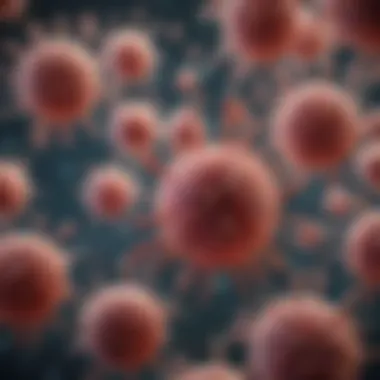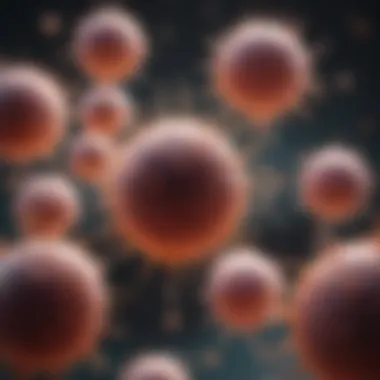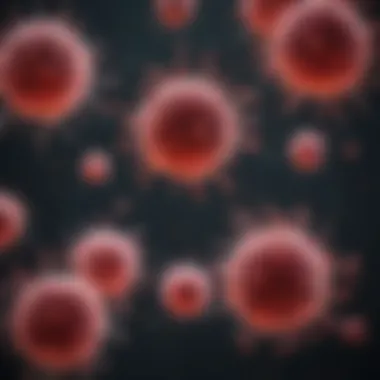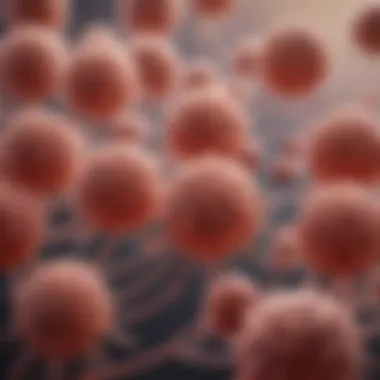Mast Cells in Humans: Functions and Implications


Intro
Mast cells are pivotal components of the human immune system. These granular cells are derived from hematopoietic stem cells and are predominantly found in tissues, especially near blood vessels and at mucosal surfaces. Their role is particularly critical in the defense against pathogens, but they also have a significant function in allergic reactions and various immunological disorders. Understanding their complex biology is essential for grasping their contributions to both health and disease.
Research into mast cells has gained momentum in recent years due to their involvement in numerous physiological and pathological processes. This overview will shed light on the biological characteristics, functions, and activation mechanisms of mast cells, providing insights into diseases such as asthma and mastocytosis. Furthermore, identifying the emerging therapeutic strategies related to mast cell functions could lead to innovative treatments.
Research Overview
Summary of Key Findings
Mast cells are equipped with a variety of receptors that allow them to respond to environmental stimuli. They release a plethora of mediators, including histamine, cytokines, and proteases, which play essential roles in immune responses. Research highlights their involvement in:
- Allergic Reactions: Activation of mast cells is a key player in the pathogenesis of allergic diseases.
- Wound Healing: They contribute to tissue repair and healing processes.
- Immune Regulation: Mast cells interact with other immune cells, modulating their activity.
Research Objectives and Hypotheses
The primary objective of research on mast cells is to elucidate their roles in various disease states. A hypothesis that has emerged is that mast cell dysregulation contributes to the severity of allergic responses and chronic inflammatory conditions. Future research aims to determine how modulating mast cell activity can lead to better therapeutic outcomes in diseases like asthma and chronic urticaria.
Methodology
Study Design and Approach
Research on mast cells usually involves a combination of in vitro studies, animal models, and human clinical trials. Various experimental approaches are implemented to explore the activation pathways of mast cells, their interactions with other immune cells, and their contributions to disease.
Data Collection Techniques
Techniques such as flow cytometry, histological analysis, and molecular biology methods are employed to gather data. Clinical studies may also utilize patient biomarkers to assess mast cell activity in diseases.
"Mast cells have a dual role in human physiology, acting both as protectors and potential contributors to disease."
Understanding mast cells' functions will advance our comprehension of immunology and expand treatment avenues for mast-related diseases.
Prolusion to Mast Cells
Mast cells play a significant role in the health and function of the human body. Understanding these cells is essential because they are key players in the immune system. Their involvement in various physiological processes, including allergic reactions and tissue repair, highlights their importance in routine health and disease.
Mast cells are often identified by their distinctive granules, which are filled with mediators like histamine. Their ubiquitous presence in connective tissues, especially near blood vessels and nerves, enables them to be the first responders in immune reactions. This also indicates their strategic location in assisting the body’s response to pathogens.
Moreover, mast cells have historical relevance, as they were one of the first cell types studied in immunology. Unraveling their characteristics and historical context provides insights into their evolution and functionality within human biology. Therefore, this overview does not only touch on their scientific aspects but also encourages readers to appreciate their complexity and historic significance in medicine.
Biological Functions of Mast Cells
Understanding the biological functions of mast cells is crucial for any exploration of human immune response and pathology. These cells are versatile components of the immune system with various roles that can significantly influence health outcomes. Their involvement ranges from responding to pathogens to participating in tissue repair. A deeper look into these functions sheds light on the benefits and complexities of mast cell activity.
Immune System Role


Mast cells are central players in the immune system. Their main role is to act at the first line of defense against pathogens. These cells exist in various tissues, especially near blood vessels and nerves, placing them strategically to respond quickly to infections or injuries. When activated, mast cells can secrete numerous mediators that initiate and modulate immune responses. These mediators include histamines, cytokines, and other signaling molecules, which help recruit other immune cells to the site of infection. Understanding their role in the immune system highlights the delicate balance they maintain between protecting the body and potentially contributing to pathological conditions.
Inflammatory Response
Mast cells are critical in orchestrating the inflammatory response. They recognize harmful stimuli and trigger localized inflammation, which is essential for healing. Here, we will discuss three significant aspects of their inflammatory functions:
Histamine Release
Histamine release is one of the most recognized functions of mast cells. Upon activation, mast cells release histamine, which increases blood vessel permeability. This characteristic is crucial during allergic reactions and infections, as it allows immune cells to access the affected areas more easily. Histamine's effects can cause symptoms such as itching and swelling, which are often associated with allergic responses. However, excessive histamine release can also lead to severe allergic reactions and anaphylaxis, demonstrating a double-edged sword nature of this response.
Cytokine Production
Cytokine production by mast cells is another vital aspect of their functionality. These proteins act as signaling molecules that facilitate communication between immune cells. Mast cells can produce various cytokines, such as tumor necrosis factor-alpha (TNF-α) and interleukins, that can influence inflammation and immune regulation. This ability to produce a diverse range of cytokines allows mast cells to modulate immune responses effectively. However, dysregulation in cytokine production can contribute to chronic inflammatory conditions, showcasing the fine line they walk in maintaining homeostasis.
Role in Allergic Reactions
Mast cells play a crucial role in allergic reactions through the mediation of hypersensitivity responses. When allergens enter the body, mast cells recognize them and degranulate, leading to the release of histamines and other inflammatory mediators. This process contributes to the symptoms associated with allergies, such as sneezing, wheezing, and increased mucus production. Their central role in allergies makes mast cells a target for therapeutic interventions aimed at managing allergic diseases, though it also poses challenges in understanding the full scope of their implications within the immune response.
Tissue Repair and Wound Healing
Mast cells are not just responders to inflammation; they also contribute significantly to tissue repair and wound healing. Upon injury, mast cells can secrete growth factors and other mediators that facilitate the repair processes. They help in managing the healing environment, promoting new tissue formation, and clearing away debris. This function highlights the dual role of mast cells as both protectors against pathogens and important contributors to recovery.
In summary, the biological functions of mast cells encompass multiple roles within the immune system, impacting both health and disease. Their involvement in inflammatory responses, tissue repair, and specifically in mediating allergic reactions underlines the importance of continued research in this area to better understand their contributions and implications for therapeutic strategies.
Mast Cell Activation Mechanisms
Mast cell activation is a significant topic in understanding how these cells function in human health and disease. The mechanisms underlying mast cell activation are intricate and involve various triggering factors and signal transduction pathways. Understanding these mechanisms can help explain mast cells” varied contributions to immune responses, allergies, and other pathological conditions. By focusing on the activation process, one can appreciate how mast cells respond to different stimuli and how this impacts overall human physiology.
Triggering Factors
Allergens
Allergens are substances that provoke an allergic response in sensitive individuals. They play a crucial role in triggering mast cell activation. The main characteristic of allergens is their ability to initiate an immune response that can lead to histamine release from mast cells. This is particularly important in the context of allergic reactions, where even small amounts of allergens can cause significant physiological changes.
The unique feature of allergens in this context is their potential to cause hypersensitivity. For instance, common allergens include pollen, dust mites, and certain foods. These substances are popular in studies related to mast cell function because they exemplify how the immune system can overreact, leading to severe clinical manifestations.
However, the challenge with allergens is that they can vary significantly in their potency and the individual sensitivity to them. This variability can complicate the understanding of mast cell activation in allergic reactions.
Infections
Infections represent another critical trigger for mast cell activation. They can arise from various pathogens, including bacteria, viruses, and fungi. Mast cells possess receptors that can recognize these pathogens, initiating an immune response. A key characteristic of infections is that they can activate mast cells both directly and indirectly through the release of inflammatory cytokines by other immune cells.
Mast cells' role in the context of infections is beneficial as they can help contain and eliminate pathogens. Their unique feature is their ability to release pro-inflammatory mediators, which can enhance the recruitment of other immune cells to the site of infection. However, excessive activation can lead to tissue damage and other complications.
Physical Stimuli
Physical stimuli include a broad range of factors such as temperature changes, mechanical stress, or UV radiation. These stimuli can also activate mast cells, and their impact on mast cell behavior is noteworthy. A key characteristic of physical stimuli is their ability to induce immediate mast cell responses, which can manifest as localized inflammation.


In this article, physical stimuli are relevant because they highlight the non-immune triggers that can influence mast cell activity. A unique aspect of physical stimuli is that they vary in their effects depending on the environment and the specific physical factors involved. While this can be advantageous in understanding mast cell reactions, it can complicate research, as outcomes may differ under diverse conditions.
Signal Transduction Pathways
The activation of mast cells is further regulated by complex signal transduction pathways, which convey information from the cell surface receptors to the internal cellular machinery. These pathways are essential for determining how mast cells respond to their environment. Understanding these pathways allows researchers to explore potential therapeutic interventions.
Mast cell signal transduction often involves various kinases and biochemicals that serve as secondary messengers. These mechanisms help in amplifying the signal, leading to a diverse range of cellular responses. Dysfunction in these pathways may contribute to pathological conditions such as allergies and autoimmune disorders.
Interaction with Other Immune Cells
The interaction of mast cells with other immune cells is a critical aspect in understanding the broader context of human immunity. Mast cells do not act in isolation; they engage in complex signaling pathways that facilitate communication with various immune cells. This cooperation allows the immune system to mount a more effective response to threats such as pathogens or allergens. Understanding these interactions is essential for identifying potential therapeutic targets, especially in conditions where mast cells are known to play a role, such as allergies and autoimmune diseases.
Cooperation with Lymphocytes
Mast cells and lymphocytes exhibit a significant degree of cooperation. Lymphocytes, especially T-cells, release cytokines that can enhance mast cell activation and proliferation. Conversely, activated mast cells can influence lymphocyte function by secreting various cytokines and chemokines. For instance, mast cells release Interleukin-4, which promotes the differentiation of naive T-cells into T-helper 2 (T) cells, enhancing the body’s allergic response.
Some studies suggest that mast cells may also help in the survival of memory T-cells, linking them more closely to long-term immune memory. This relationship appears essential in conditions like asthma, where the immune response must be both rapid and long-lasting. The balance between mast cell activation and lymphocyte function can determine the severity of allergic reactions and other immune-mediated pathology.
Modulation of Dendritic Cells
Dendritic cells play an important role in the interplay between mast cells and the immune system. They are antigen-presenting cells that capture and present antigens to T-cells, commencing the adaptive immune response. Mast cells can influence dendritic cell functioning through several pathways. For example, activated mast cells can release TNF-alpha and other mediators that enhance the maturation of dendritic cells.
This modulation can lead to an acute inflammatory response, which is vital when the body is confronted by pathogens. Moreover, mast cell-induced changes in dendritic cells can lead to differences in the type of T-cell response generated. This interaction can significantly impact the balance between inflammatory and regulatory pathways in the immune system.
Furthermore, there is evidence that through the secretion of mediators, mast cells can generate tolerogenic responses in dendritic cells. This function could contribute to how the body tolerates certain antigens, highlighting the dual role of mast cells in both promoting and regulating immune responses.
"The interplay between mast cells and other immune cells is a dynamic and critical component of immune system function, influencing outcomes in health and disease."
Mast Cells in Disease Pathophysiology
Mast cells play a significant role in several pathological conditions, and understanding this aspect is crucial for recognizing their implications in health and disease. These immune cells contribute substantially to the mechanisms of various diseases, particularly those involving allergic responses, inflammation, and other immune-related disorders. Their ability to release numerous mediators makes them influential in disease progression and therapy. Highlighting the importance of mast cells in disease pathophysiology allows us to grasp how manipulating their functions could lead to novel treatments and improved management of health conditions, from allergies to autoimmune diseases.
Role in Allergies and Asthma
Mast cells are central players in allergic reactions and asthma. When exposed to allergens, mast cells respond by degranulating and releasing substances such as histamine, which causes symptoms like itching, swelling, and bronchoconstriction. This reaction is not only rapid but also can escalate to anaphylaxis in severe cases.
The release of cytokines by mast cells also enhances the recruitment and activation of additional immune cells like eosinophils and T lymphocytes. This creates a vicious cycle of inflammation and tissue damage, leading to chronic conditions such as asthma. Research continues to explore targeted therapies that inhibit mast cell activation or block specific mediators, aiming to provide better relief for individuals suffering from allergic diseases.
Mastocytosis and Other Disorders
Mastocytosis is a disorder characterized by an abnormal accumulation of mast cells in various tissues. This condition can present in different forms, ranging from localized skin lesions to systemic involvement affecting internal organs. Patients with mastocytosis may experience symptoms that resemble allergic reactions even in the absence of identifiable allergens. These symptoms can include abdominal pain, flushing, and bone pain.
Current approaches to manage mastocytosis focus on symptom control and reducing mast cell burden. New discoveries in mast cell biology offer insights into potential targeted treatments. Understanding mast cell behaviors in mastocytosis can further lead to innovative therapies, significantly improving the quality of life for affected individuals.
Mast Cells in Autoimmunity


Mast cells also exhibit a relevant role in autoimmune diseases, where the immune system mistakenly targets the body's own tissues. In these conditions, mast cells can contribute to inflammation and tissue damage, perpetuating the autoimmune process. Studies have shown that mast cells can interact with autoreactive lymphocytes, thus amplifying the inflammatory response.
Disorders such as rheumatoid arthritis and lupus erythematosus may exhibit an altered mast cell activation pattern, suggesting a complex role in disease etiology. Understanding the mechanisms by which mast cells operate in autoimmunity opens avenues for therapies aimed at modulating their function. Research continues in hopes of uncovering effective strategies to mitigate the impact of mast cells in these chronic conditions.
"The complexities of mast cell biology underline their dual roles in protecting against pathogens and contributing to disease, making them a compelling target for future research."
In summary, mast cells have a profound involvement in various diseases, highlighting their importance in both allergy and disease pathophysiology. Recognizing this allows us to better appreciate their role in health and the potential for targeted therapies.
Research Advances and Therapeutic Implications
Research on mast cells has significantly expanded in recent years, highlighting their complex roles in both health and disease. Understanding these roles has implications for therapeutic strategies targeting various conditions. This section emphasizes the importance of innovative approaches to harness the functions of mast cells, addressing specific elements, benefits, and considerations associated with the latest advancements in research.
Innovative Therapeutic Approaches
New therapeutic strategies are emerging in the treatment of conditions mediated by mast cells. For example, monoclonal antibodies are being developed to inhibit components associated with mast cell activation and release. Such treatments target the IgE-mediated pathway, which plays a crucial role in allergic responses.
In addition to monoclonal antibodies, small molecules that inhibit mast cell degranulation are under investigation. These compounds may help in the management of chronic disorders like asthma and other allergic conditions.
Furthermore, research is exploring the modulation of mast cell activity through dietary components and bioactive compounds. Probiotics and certain flavonoids have shown promise in regulating mast cell functions, potentially providing a holistic approach to treatment.
Benefits of these innovative approaches include:
- Reduced Side Effects: Targeted therapies can minimize adverse effects often associated with traditional medications.
- Improved Efficacy: Personalized medicine tailored to mast cell involvement can enhance overall treatment outcomes.
- Broader Applications: Understanding mast cell functions could enable new treatments for various diseases beyond allergies, including cancer and autoimmune disorders.
Future Research Directions
Future research is essential to further comprehend mast cell biology and its therapeutic potential. Current directions may include:
- Targeted Gene Therapy: Researchers are exploring the possibility of correcting genetic mutations that affect mast cell function, which could offer a ground-breaking approach in treating mastocytosis.
- Biomarker Identification: Identifying specific markers related to mast cell activation could lead to more accurate diagnosis and personalized treatment protocols.
- Reconceptualizing Mast Cell Roles: Ongoing studies aim to understand mast cells’ dual role in immunity and tissue repair, potentially revolutionizing their perceived function in various diseases.
- Investigating Extracellular Vesicles: Research into the role of extracellular vesicles derived from mast cells could provide insights into intercellular communication and inflammation regulation.
"Understanding the nuanced roles of mast cells in health can lead to novel therapies that go beyond conventional approaches, addressing the root causes of various diseases."
Closure
The conclusion of this article encapsulates the complex and significant role of mast cells in human biology. Mast cells are not just passive entities; they play a dynamic role in various physiological and pathological processes. Their diverse functions in the immune system, including involvement in allergies, asthma, and tissue repair, underpin their importance in both health and disease. Understanding mast cell biology is crucial for comprehending how immune responses are regulated and how these cells can contribute to or alleviate disease.
Summary of Findings
The exploration of mast cells throughout this article reveals several key insights:
- Immune Modulation: Mast cells are integral to the immune defense, participating actively in allergic responses and offering protection against pathogens.
- Inflammatory Mediators: By releasing mediators such as histamine and cytokines, mast cells orchestrate inflammatory processes that are essential for healing and defense mechanisms.
- Pathological Contributions: Conditions like asthma, allergies, and mastocytosis illustrate that while mast cells are vital for health, their dysregulation can lead to significant morbidity.
Mast cells, therefore, serve as a double-edged sword, aiding in recovery while also being implicated in various disorders. These findings highlight the need for a nuanced understanding of their function in different contexts.
Implications for Future Research
The insights gained from studying mast cells open various avenues for future research, which could lead to innovative treatment strategies. Key areas to consider include:
- Therapeutic Targeting: Further studies may explore targeted therapies aimed at mast cell stabilization or modulation, potentially offering relief for those suffering from allergic conditions.
- Chronic Conditions: Investigating the role of mast cells in chronic inflammatory diseases can yield valuable information that might contribute to new treatment modalities.
- Novel Biomarkers: Research could also aim to identify biomarkers related to mast cell activation or deactivation, assisting clinicians in diagnosis and treatment efficacy monitoring.
The continuing exploration of mast cells will likely reveal their multifaceted influences on health and disease. This research is essential as it could lead to breakthroughs that significantly improve patient outcomes in various conditions.
"Mast cells play pivotal roles in immunology, and understanding their functions thoroughly may uncover therapeutic opportunities previously unrecognized."















